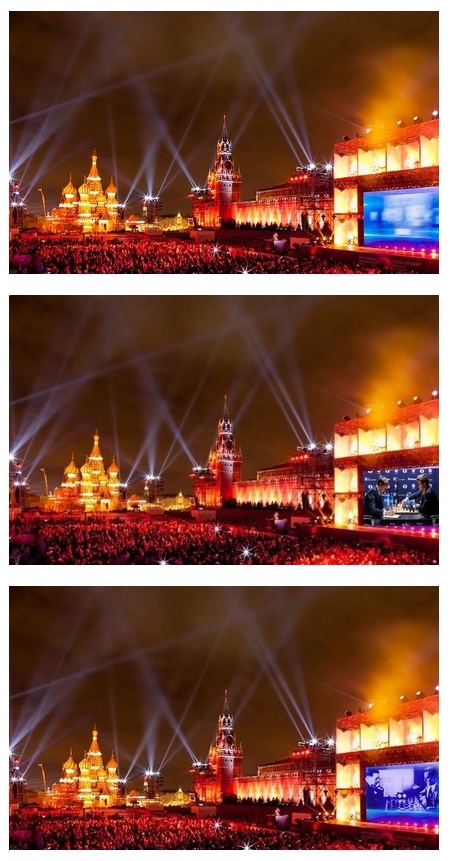
Edward Winter

See C.N. 10237, where we commented:
Hoaxers exploit ignorance, haste, laziness and wishful thinking, which makes the chess world a natural target.
This general article on chess hoaxes (and suspected hoaxes) complements, but does not repeat, the following:
A Non-Existent Blindfold Chessplayer
The Alekhine v Nenarokov Hoax
A Fictitious Chess Book
The Garry Kaspartov Scam
Alleged Games by Einstein and Stalin
Copying
Capablanca v Steiner (Living Chess)
A Chess-Billiards Concoction
Jean-Jacques Rousseau and Chess
Grimshaw v Steinitz
Chess and Ghosts
An Anderssen Loss?
A Chess Whodunit
A Fake Chess Photograph
The Capablanca-Pokorny Fiasco
Napoleon Bonaparte and Chess
An Indian Copying Mystery
Who Was Birdie Reeve?
The Consultation Game That Never Was
The Gibaud v Lazard Gamelet
Chess Myths
The Cambridge v Bedlam Chess Story
A Publishing Scandal
The Caissa-Morphy Puzzle
My 61 Memorable Games (Bobby Fischer)
The Chess Writer P. Wenman
Adams v Torre – A Sham?
C.N. 198 briefly discussed the meeting in the early 1920s between Reshevsky and Charlie Chaplin. There are two well-known photographs of the celebrities in play against each other; in addition, page 191 of Chess Life & Review, April 1979 reproduced a shot of the prodigy watching a game between Douglas Fairbanks and Charlie Chaplin.
A decade or so ago we noted that the following alleged game between Chaplin and Reshevsky had been published on page 414 of Şah Cartea de Aur by Constantin Ştefaniu (Bucharest, 1982), with a claim (devoid of any source) that it had been won by Reshevsky in New York in 1923:
1 e4 e5 2 Nf3 Nf6 3 d4 exd4 4 e5 Ne4 5 Qe2 Nc5 6 Nxd4 Nc6 7 Be3 Nxd4 8 Bxd4 Ne6 9 Bc3 Be7 10 Nd2 O-O 11 Ne4 d5 12 O-O-O Bd7 13 Ng3 c5 14 Bd2 b5 15 Nf5 d4 16 h4 Nc7 17 Nxe7+ Qxe7 18 Bg5 Qe6 19 Kb1 Nd5 20 g3 Nb4 21 b3 Qa6 22 a4 Qa5 23 Kb2 bxa4 24 Ra1 Rab8 25 Kc1 a3 26 Bd2 Be6 27 Bxb4 cxb4 28 Qa6 Qc5 29 Bc4 Rbc8 30 White resigns.
We submitted the game-score to Frank Skoff, who scrutinized the matter in considerable detail in Chess Life, December 1992 (page 37) and June 1994 (page 10), reaching the following conclusion:
‘The game is a myth, to phrase it delicately, though some would bluntly call it a hoax. All that is left is the score, the origin of which is practically impossible to track down since it would have been copied from any game anywhere, or perhaps even composed by the perpetrator, man the myth-making animal in either case.’
(2875)
When giving the text of C.N. 2875 in a ChessBase article dated 24 April 2008, we included this photograph from page 2 of the January 1922 American Chess Bulletin ...
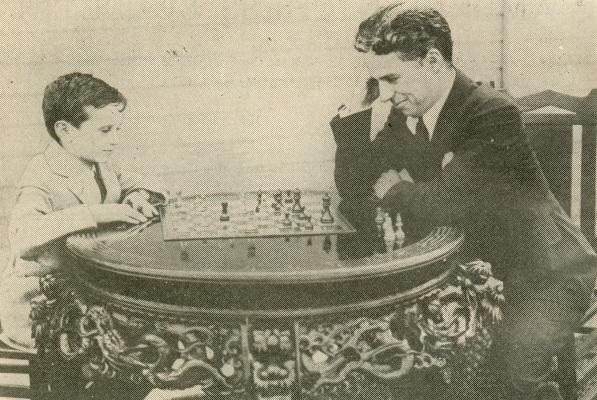
... and we noted that a signed copy (‘To my friend Sammy With very best wishes From Charlie Chaplin’) was published on page 320 of the October 1963 Chess Review.
See also our feature article The Chess Prodigy Samuel Reshevsky.
Information about chess impostors will be gratefully received. The May-June 1923 American Chess Bulletin (page 112) quoted from The Brazilian American (Rio de Janeiro) a sceptical account of ‘a visit from a Dr Max Blumenfeld, who had arrived on the Lutetia from Belgium’. Wishing to give a simultaneous display, he said that he was a professional chessplayer who had won tournaments in Warsaw and Vienna and had defeated the Belgian champion, Colle. He claimed to have invented a ‘Blumenfeld Gambit’ in the Queen’s Pawn Opening and ‘he also showed us a couple of end games of his composition, which he has authorized us to publish as original contributions to our column’.
Page 110 of the American Chess Bulletin reproduced one of these, with the heading ‘End Game, by Dr Max Blumenfeld, Poland’. The next issue (July-August, page 136) contained a letter from D. Przepiórka of Warsaw pointing out that the study was by him; it was first published in Szachista Polski in 1920 and repeated in a number of journals. The letter added that no Dr Max Blumenfeld was known in Poland, although Beniamin Blumenfeld of Moscow was the originator of the Blumenfeld Gambit, an opening made famous by the game Tarrasch v Alekhine, Pistyan, 1922.
The study in question may be found, correctly ascribed to Przepiórka, on page 187 of 1234 Modern End-Game Studies by M.A. Sutherland and H.M. Lommer (London, 1938), page 254 of A.J. Roycroft’s Test Tube Chess (London, 1972) and pages 125-126 of David Przepiórka, A Master of Strategy by H. Weenink (Amsterdam, 1932). Where ‘Dr Max Blumenfeld’ came from and went to we do not know.
(2027)
In C.N. 700 we reported from our reading of Europe Echecs:
A hoaxer, named as Jean-Marie Morisset of Rouen, is at work, creating spurious games claimed to have been played by various ‘celebrities’ (Delius, the Pope, etc.).
The deception, uncovered by Marc Durand, was written up in a number of magazines at the time, and a feature on pages 192-193 of the May 1984 BCM quoted a sentence from a long letter of apology from J.-M. Morisset: ‘J’espère que vous me pardonnez mon impudence’.
The hoaxes concerned various invented games and problems, the most notorious specimen being a 1946 game between the future Pope John Paul II and ‘Wanda Zartobliwy’. It emerged that ‘Żartobliwy’ is the Polish word for ‘facetious’ or ‘jocose’.
For further information, readers are referred to page 17 of The Even More Complete Chess Addict by M. Fox and R. James (London, 1993) and, in particular, the article ‘No Chess in the Vatican’ by Tomasz Lissowski on pages 306-310 of the Winter 2000 issue of the Quarterly for Chess History. The Quarterly published a follow-up piece on pages 366-367 of its Spring 2001 issue. For Hans Ree’s account of the trickery, see pages 76-77 of the 3/2001 New in Chess.
Of course, the hoax has become so well known that no competent chess writer would fall for it today.
(3118)
Larry Evans fell for it on page 44 of Chess Life, January 2004.
From Larry Evans’s column on page 6 of the Winter 2004 Chess Life:
‘Although widely quoted in many other sources, apparently the problem and game attributed to Pope John Paul II in my column last January is [sic] a hoax.’
(3696)
A strange position allegedly from a game between Alekhine and Bogoljubow (‘Vienna, 1922’) has been published in a number of places (e.g. on page 180 of the Skinner/Verhoeven book on Alekhine). At the Chess History Center website conducted by Richard Forster it has now been revealed, following research by Jack O’Keefe, that it was all a joke/hoax by J. Krejcik, who gave the position on pages 39-40 of his book 13 Kinder Caïssens (Vienna, 1924).
(2463)
From the ‘Simultaneous Display’ entry in The Encyclopedia of Chess by Harry Golombek (London, 1977 and Harmondsworth, 1981):
‘It is also reported that a certain Dr Backer played 1,000 games in San Francisco 1938 with the result +343 –138 =519.’
Golombek’s words appeared in the section on exhibitions given on a replacement basis (i.e. with new games beginning as others are completed).
Whether such a display ever occurred was a question raised in C.N. 899 by Hugh Myers (Davenport, IA, USA), who pointed out that ‘Backer’ is usually given as ‘Basker’. Our correspondent quoted from page 122 of the March 1938 BCM (of which Golombek was then the General Editor):
‘San Francisco. A certain Dr Basker has succeeded in performing the herculean task of playing 1,000 boards simultaneously. His results were (after four days’ play) 343 wins, 138 losses and 519 draws.’
The story was widely reported. For example, the following was published on page 100 of the Australasian Chess Review, 30 April 1938:
‘A certain Dr Basker, of San Francisco, is reported to have played 1,000 games simultaneously. After four days’ play, he finished up with a score of 343-137 [sic], and 519 draws. We assume that his opponents came along in relays or waves, with day and night shifts.’
Finally, from page 337 of CHESS, 14 June 1938:
‘Several magazines and journals have reported that a certain Dr Basker, of San Francisco, has played 1,000 opponents simultaneously, winning (after four days’ play) 343, drawing 519, losing 138. We believe the whole thing is a hoax.’
Does any reader know more about the affair?
(3230)
We have it on the authority of Raymond Keene that after the fourth game of the 2004 Kramnik v Leko match in Brissago Peter Leko declared:
‘My cousin Sammy told me a true slugger – a Szeged slugger – will always swing for the fences, and that is exactly what I am going to do. I am going to knock Kramnik out of the room with my “home run punch”. My trainer and I have been developing it in camp. I just hope Vladimir’s head is screwed on tight or it may end up on top of the demonstration board!’
After quoting these words, on page 114 of his book World Chess Championship Kramnik vs. Leko, Mr Keene reported:
‘Kramnik made a face – and a fist – but chose to reserve a fuller reply for the chessboard.’
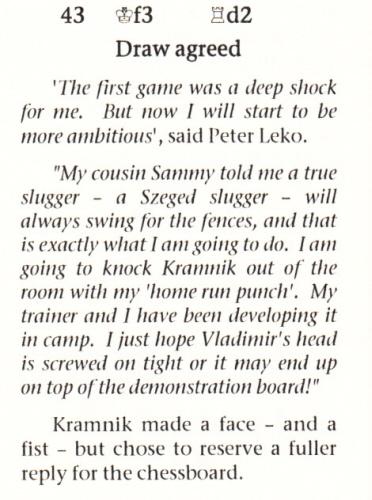
But did Leko, a gentleman, speak any of those words attributed to him by Mr Keene? Drawing this matter to our attention, Alan O’Brien (Mitcham, England) writes:
‘It struck me that this mix of boxing and baseball terminology sounded unusual coming from a Hungarian, so I decided to trace the source of the quote. The first time I have found it mentioned is at http://www.chessgames.com/perl/chessgame?gid=1306947&kpage=59. In a posting dated 3 October 2004 somebody using the pseudonym “Offramp” asserted that the words quoted above (completed with “I will knock Kramnik senseless. He is going down in game five. And he is going down HARD!”) had been spoken by Leko during a press conference after game 4.
Incidentally, Raymond Keene mentions the www.chessgames.com site many times in his book on the match, but not in this case.
I was curious as to where “Offramp” had obtained the quote, and at the webpage http://www.eastsideboxing.com/news/sternburg2210.php I found the following text:
“Sosa: ‘I’m Going to Knock Manfredy Out of the Park!’
… Dominican national lightweight champion Victoriano Sosa predicted a ‘home run-style’ knockout against former WBU champion Angel Manfredy when they rumble, Saturday, 9 November, on the pay-per-view extravaganza ‘Real Fights!’ …
Sosa, the cousin of Chicago Cub home run king Sammy Sosa, spoke today from his training camp outside Chicago …
‘My cousin Sammy told me a true slugger – a Sosa slugger – will always swing for the fences’, said Sosa. ‘And that is exactly what I am going to do. I am going to knock Angel out of the ring with my “home run punch”. My trainer and I have been developing it in camp. I just hope Manfredy’s head is screwed on tight or it may end up in the bleachers!’ …
‘I will knock Manfredy senseless. He is going down in five. And he is going down HARD!’”’
Yet another memorable episode …
(3752)
An obvious ChessBase hoax:

Who would fall for that?
From the chessgames.com page of Dennis Monokroussos:

A remark in Cuttings:
Guile and gullibility complacently co-exist.

From Olimpiu G. Urcan (Singapore):
‘This picture, which originated on an anonymous Twitter account on 30 November 2016, has been widely published on the Internet, and notably in a Huffington Post article the following day.
It is an obvious concoction from a 2011 photograph. Such compositions are easy to make, and it took me just a few minutes to adapt the same original picture to include the fake Alekhine v Capablanca photograph:’

Hoaxers exploit ignorance, haste, laziness and wishful thinking, which makes the chess world a natural target.
(10237)
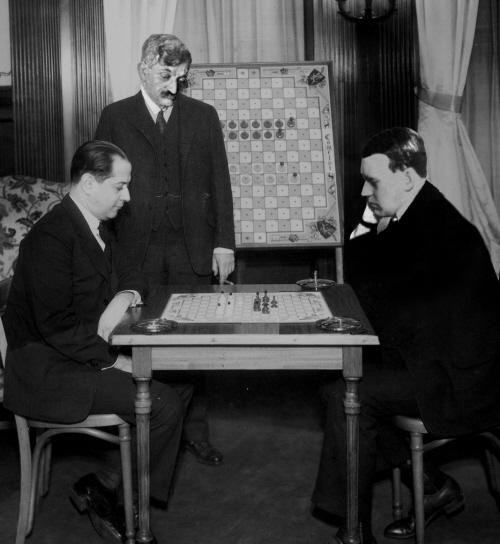
The above photograph (Capablanca, Lasker and Alekhine) comes from a webpage of the World Camelot Federation, and we reproduce it with the permission of the Federation’s President and Founder, Michael Nolan (Troy, MI, USA). He informs us that he created it on the basis of this picture:
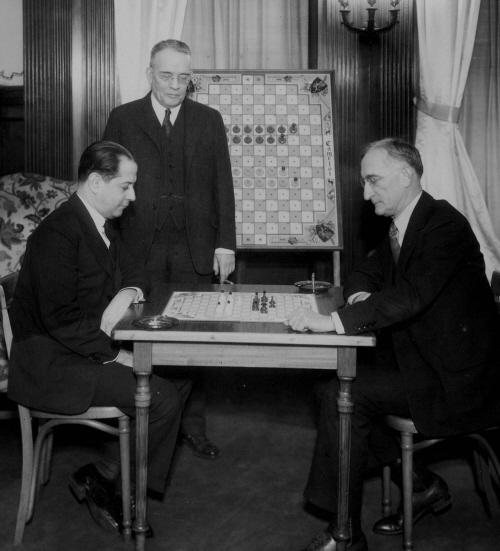
Here, Capablanca’s opponent is the Camelot and bridge expert Sidney Lenz, while E.V. Shepard (another bridge authority) looks on.
(7164)
C.N. 3439 (see A Chess Whodunit) quoted from a letter dated 27 March 1926 from John G. White to John Keeble:
‘I am surprised at your telling me that Mr Murray still believes in the Rou Manuscript. Fiske dearly loved such mystifications in his younger days, and when his memory of this particular one was revived by my correspondence with him the zest returned – hence his correspondence with Notes & Queries and his later elaborate attempts to bolster up the story. How he came to father it on the particular person that he did I do not know, and cannot guess, but I presume his reading advised him of the existence of the person and he knew it would be impossible to dispute his statement. I think in former letters I have told you of some of his more elaborate hoaxes.’
We asked for information about hoaxes allegedly perpetrated by Fiske, and the matter has now been taken up by Harrie Grondijs on pages 52-54 of volume four of Chess Craze Bad (Maastricht, 2017), a 237-page hardback subtitled ‘Daniel Willard Fiske, chess bibliophile and chess visionary’.
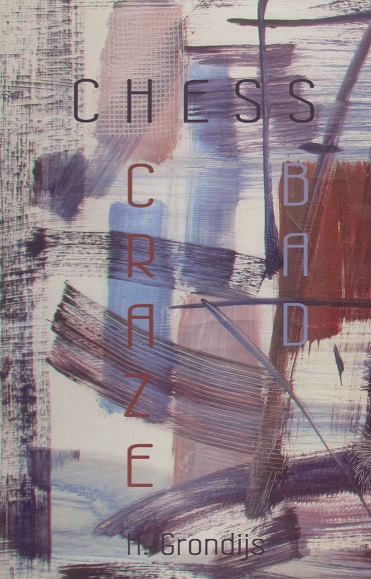
The relevant section, entitled ‘A real Fiske hoax’, follows up on the account of Fiske and Frère’s involvement in the Morphy-Staunton controversy in Chapter four of Thomas Frère and the Brotherhood of Chess by Martin Frère Hillyer (Jefferson, 2007). In describing a rancorous public argument between ‘Pro Recto’ and ‘Sancho Panza’, Martin Frère Hillyer identified the pseudonymous letter-writers as Fiske and Frère respectively, but Mr Grondijs demonstrates, with documentary proof, that this is not so. From page 53:
‘... the letters on both sides were written by Fiske: he played the parts of both “Pro Recto” and “Sancho Panza”.’
Produced in accordance with Harrie Grondijs’ usual fine standards, volume four of Chess Craze Bad has a print-run of only 37 copies. A comprehensive list of his books can be found in the catalogue of the Royal Library in The Hague.
(10439)
From pages 15-16 of Wonders and Curiosities of Chess by Irving Chernev (New York, 1974):
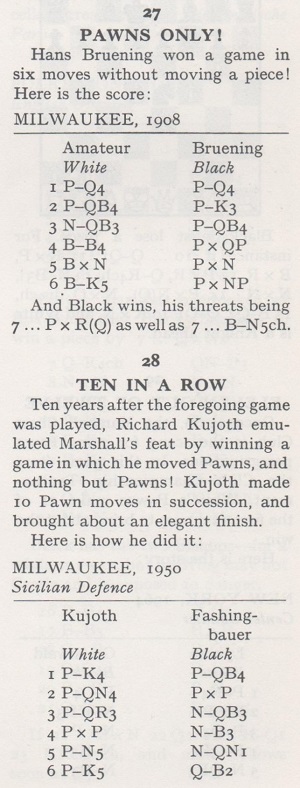
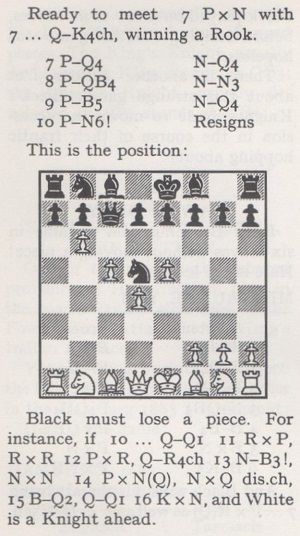
The game N.N. v Bruening was discussed in C.N. 4638.
Regarding Kujoth v Fashingbauer, we have received the following from Mark Erickson (Richland, WA, USA):
‘Andrew Soltis’s “Chess to Enjoy” column on pages 12-13 of the April 2009 Chess Life, entitled “The Hoax is on You”, included the famous miniature Kujoth v Fashingbauer, Milwaukee, 1950 (1 e4 c5 ... 10 b6 “and Black resigned on move 16”) and stated:
“When the game was published, some Europeans laughed at the rather obvious hoax ...” (Soltis cast particular doubt on Black’s name.)
The letters column on page 6 of the August 2009 Chess Life printed a reply from Kujoth. He reported that his book Chess is an Art had two games against John Fashingbauer, and he made some odd statements:
- “The second game, involving ten-consecutive-pawn moves in the Wing Gambit ...” In fact, that was the first of his two games against Fashingbauer given in Chess is an Art (ten-pawn-move game: 1950, game 39; the other game: 1951, game 40);
- Without consulting Kujoth, a columnist named Averill Powers had truncated the well-known game from 28 moves to ten in his column, entitled “The Game of Kings” in the Milwaukee Journal of 21 May 1950. Kujoth also asserted, without further explanation: “I have just completed a discussion with Myron Katz, attorney at law in Milwaukee.”
In his response on the same page of the August 2009 Chess Life, Soltis gave a 28-move version of the Sicilian Defense game supplied by Kujoth (“his original handwritten score of the game”). The issues of Chess Life can be read on-line.
Nonetheless, in his own book, Chess is an Art, published much earlier, Kujoth himself had stated that Black resigned at move ten. From pages 106-107:
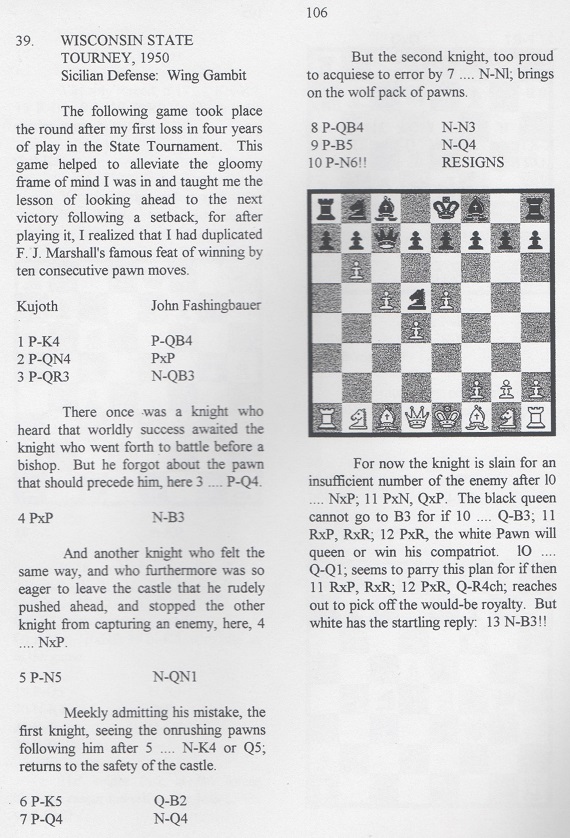
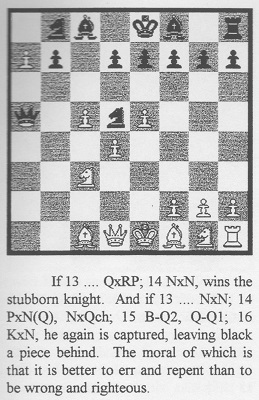
Moreover, in his Introduction to the book Kujoth referred approvingly to two works, by Chernev and Sokolsky, which had given the ten-move version.
Why did Kujoth change his position in 2009, denying that the game had lasted only ten moves?’
The title page of the book referred to by Mr Erickson:
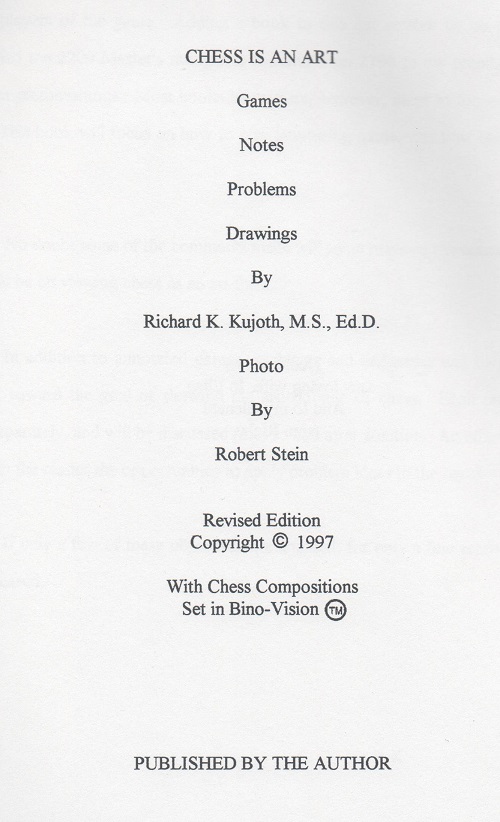
We have this edition (where the games against Fashingbauer, numbers 37 and 38, are on pages 47-49):
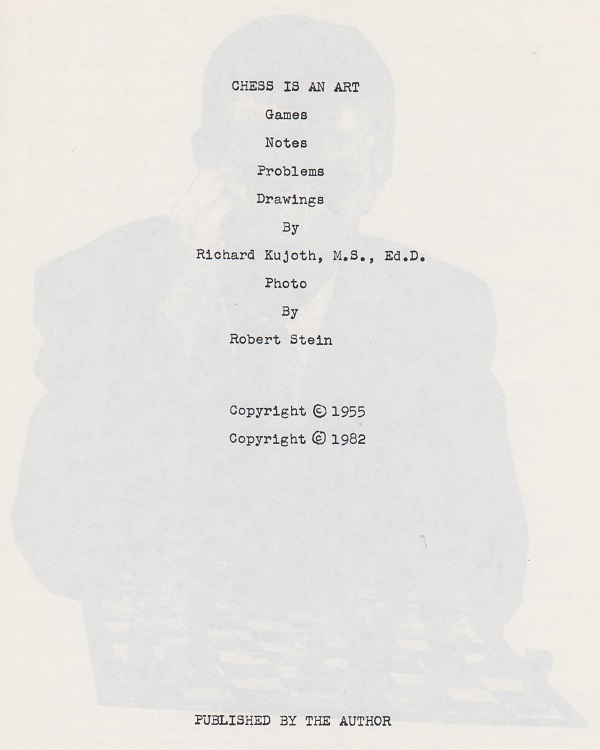
The 21 May 1950 Milwaukee Journal column has yet to be found.
(11790)
To the Archives
for other feature articles.
Copyright Edward Winter. All rights reserved.